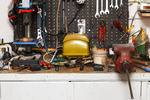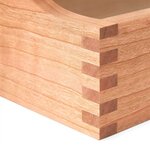We may receive a commission when you use our affiliate links. However, this does not impact our recommendations.
 After completing the hull and the deck of our boat (read parts 1 and Part 2) we were ready to shape the masts and booms. I gave Thano some short scrap pieces of dowels and he shaped a nice finial at their tip using a rasp and file.
After completing the hull and the deck of our boat (read parts 1 and Part 2) we were ready to shape the masts and booms. I gave Thano some short scrap pieces of dowels and he shaped a nice finial at their tip using a rasp and file.
Our boat’s mast was made from two dowel segments – a thick dowel at the bottom for the Main Mast and a thinner one glued over it for the Main Topmast. To make the connection between the thin and the thick masts stronger, Thano flattened two facets at the joining surfaces. Then, to add a more realistic touch to the boat’s mast, we decided to make and install a crow’s nest at the junction between the two parts of the mast. From a small piece of wood Thano shaped the outline of the nest and then he drilled two holes into it. One was a through hole (for the Main Topmast) and the other was a shallow hole for the top of the Main Mast to nest in it. Lastly, to secure the glue joint even further, I taught Thano how to tie a Common whipping knot around the two.



Connecting the boom and the gaff to the mainmast was a fun activity for Thano. I showed him how to take a short segment of metal wire (steel brass or even copper will do just great) and twist it to create a hoop and a coiled tail. Then we drilled a hole in the end of the boom and glued in our custom made Screw eye. We then threaded another segment of wire through the first Screw eye, coiled it and installed it into the hole we drilled in the mast.

After both boom and gaff were joined to the mast, we glued the mast’s base, the bowsprit and the flagpole into the holes which we pre-drilled into the deck. Now we turned to the rigging. Using a cotton string we tied up most of the parts together into a configuration that looks realistic.

At that point, the boat project was completed. Had we more time, we would probably come up with a color scheme for the hull and perhaps for the deck, but even without color, this boat looks spectacular. Building a boat like this a great project for young children as they learn how to saw, chisel, gouge, rasp, and file. Additionally, they have the chance to work with pliers, nippers, strings, and glue to make a piece that, as one of the readers who commented on this blog story wrote, will proudly stand on the family’s mantle for decades to come.
– Yoav Liberman

Here are some supplies and tools we find essential in our everyday work around the shop. We may receive a commission from sales referred by our links; however, we have carefully selected these products for their usefulness and quality.










